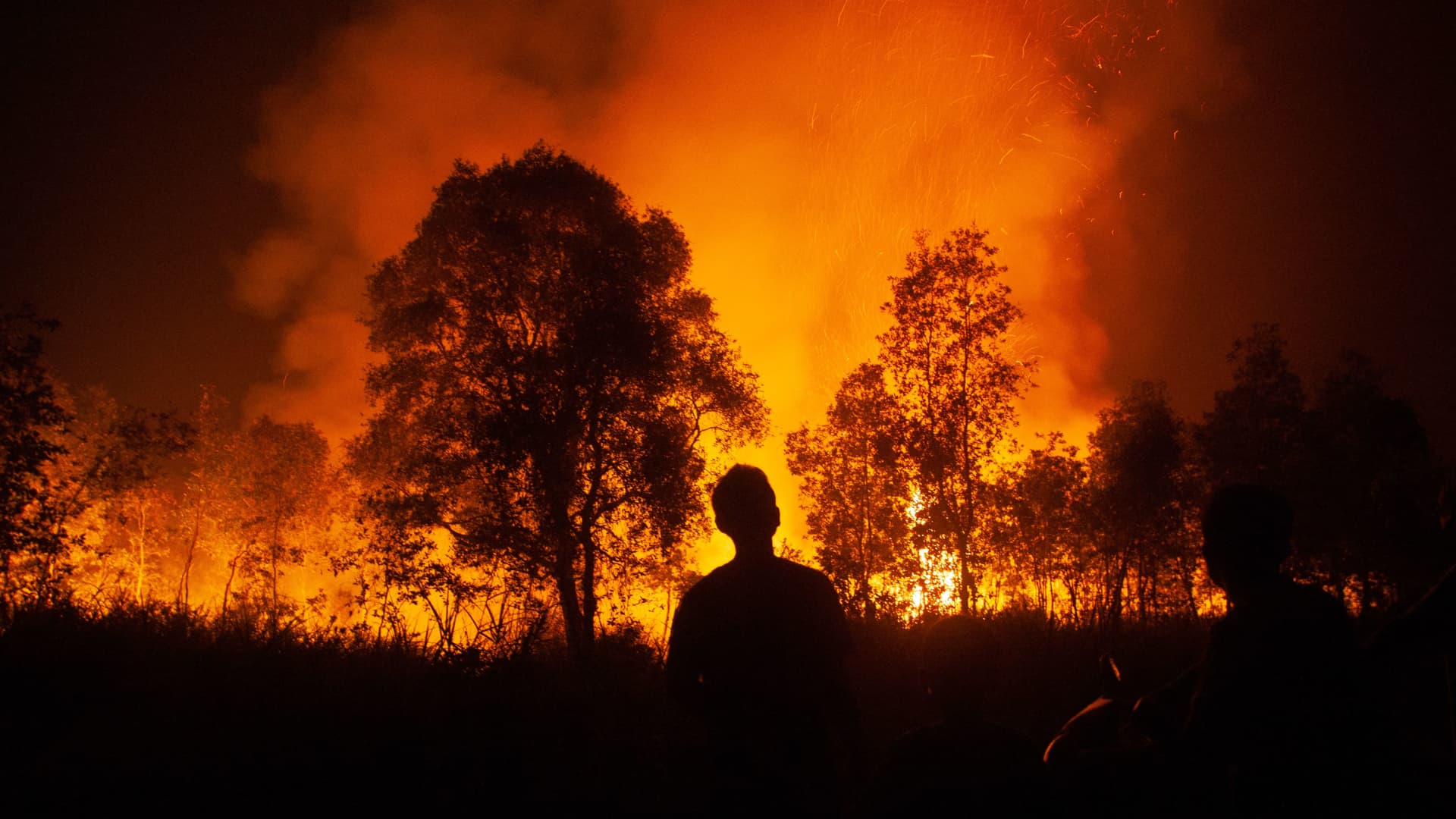Southeast Asia haze returns as peatland fires fan global warming fears


In this photo taken on October 10, 2023, a man looks at a forest fire as it approaches houses in Ogan Ilir, South Sumatra.
Al Zulkifli | Afp | Getty Images
With El Nino in full force, officials are bracing for the worst transboundary haze in southern Southeast Asia since before the pandemic in 2019.
At a time when climate change is presenting an existential threat to human beings, the fear is that these seasonal haze situations will worsen as intensifying global warming renders the peatlands and forests even more combustible in the dry season.
Southeast Asia is home to about 40% of the world’s total peatlands, and these fires and resultant emissions and toxic haze are turning out to be a serious driver of climate change.
This further complicates the perennial transboundary haze problem for Southeast Asia, which plagued the region in the dry seasons for half a century, leading to a litany of respiratory and other health issues, deaths and economic losses in the region.
“It’s a circular thing actually,” Helena Varkkey, associate professor of environmental politics and governance at Universiti Malaya in Kuala Lumpur, told CNBC.
“The issue is that currently, most governments haven’t really looked at the haze and climate change as a unified issue, yet. They see it as separate issues. Something seasonal, that comes and goes, while climate change is something constant and developing,” she added.
Despite a series of Southeast Asian agreements — including a reaffirmation of a commitment to haze-free skies by 2030 — the haze returned this year, raising questions about the effectiveness of ASEAN as an organization since many of its agreements lack enforcement mechanisms.
Bickering in Southeast Asia
The perennial bickering and denials among affected Southeast Asian nations is one of the unintended results.
Even as air quality dipped to dangerous levels in parts of Peninsular Malaysia in the last few weeks, Indonesia flatly denied Malaysia’s claims that winds carried some of the hazardous haze from hotspots in Sumatra and Kalimantan over to its neighbor.
“We continue to follow developments and there is no transboundary haze to Malaysia,” Indonesia’s Environment Minister Siti Nurbaya Bakar said in a statement dated Oct 2.
Her denial echoed past Indonesian leaders. In 2015, then Indonesian Vice-President Jusuf Kalla scolded neighboring countries for complaining about the haze.
“For 11 months, they enjoyed nice air from Indonesia and they never thanked us,” the Jakarta Globe reported him as saying.
Peatlands are one of the greatest allies and potentially one of the quickest wins in the fight against climate change.
United Nations Environment Program
Malaysian officials are undoubtedly haunted by the memory of the 2015 and 2019 transboundary haze episodes. In 2015, the last time El Nino worsened the impact of the dry season, 2.7 million hectares of forest were burned in Indonesia.
The haze that year blanketed not just Brunei, Malaysia, Indonesia and Singapore, but also southern Thailand and southern Philippines in September and October. School closures were effected in Indonesia, Malaysia and Singapore — affecting nearly four million students in Malaysia alone.
Even though a comparatively smaller forest area combusted in Indonesia in 2019 at 1.6 million hectares, the World Bank estimated peat fires in Sumatra and Kalimantan likely cost Southeast Asia’s largest economy damages worth at least $5.2 billion, or 0.5% of its gross domestic product that year.
People look at the airport scenery during the haze at the Kuala Lumpur International Airport on October 8, 2023.
Nurphoto | Nurphoto | Getty Images
Data from Indonesia’s environment ministry suggest more than 267,000 hectares of forests were burned until August this year, reportedly outstripping the nearly 205,000 hectares for all of 2022. Still, this year’s fires have devastated a much smaller area compared to 2015 and 2019.
But with the return of El Nino this year, officials are bracing for worsening fires this dry season as the number of hotspots will likely peak in September and October. The ASEAN Specialized Meteorological Centre in Singapore raised its transboundary haze alert level to its second highest for Kalimantan in July and for Sumatra in September.
Vicious cycle in the peatlands
The haze in southern Southeast Asia is emitted mostly from massive peatland fires in Sumatra and Borneo. Dried out peatlands — drained and cleared for mainly palm oil and pulp plantations — make them very prone to fires.
“The waterlogged conditions of the peatlands keep the organic material from decomposing, making it a powerful carbon sink,” Varkkey and Sharon Seah, senior fellow at the Climate Change in Southeast Asia Program at ISEAS Yusof Ishak Institute in Singapore, said in an article dated Oct. 11.
A view of burnt peatlands and fields on September 23, 2023 in Ogan Ilir, South Sumatra, Indonesia. At least six provinces in the country are battling ongoing forest fires as illegal blazes to clear land for agricultural plantation take control causing respiratory illnesses and biodiversity loss. The nation’s meteorology agency forecasted that Indonesia is likely to experience the most severe dry season since 2019 as the country enters the hottest day of this year’s El Nino-induced dry season.
Ulet Ifansasti | Getty Images News | Getty Images
“When drained in preparation for planting or other development activities, the organic material is exposed to the air, kick starting decomposition and the release of greenhouse gasses. When burnt, this process is accelerated, further speeding up global warming,” they added.
According to the United Nations Environment Program, peatlands store nearly 550 billion tons of carbon — twice as much as all the world’s forests — even though peatlands cover only 3 per cent of the global land surface.
“Peatlands are one of the greatest allies and potentially one of the quickest wins in the fight against climate change,” the UNEP said. “By conserving and restoring peatlands globally, we can reduce emissions and revive an essential ecosystem that provides many services, including their role as a natural carbon sink.”
Sustainable palm oil
Tying the transboundary haze problem to climate change would involve addressing the root issues of these peatland fires in Indonesia, but with Indonesia the world’s largest palm oil producer, that may not be easy.
While Indonesia’s environment minister denied the haze has crossed beyond the borders of her country, she highlighted that 203 companies have been warned so far this year and 20 companies have been sealed off due to fire, including Malaysian subsidiaries.
Clearly, the transboundary haze issue is a multifaceted issue involving several stakeholders. The onus does not only fall on Indonesia alone since companies from neighboring countries are also invested.
To complement several Southeast Asian regional agreements on curtailing the transboundary haze, Singapore enacted its Transboundary Haze Pollution Act in 2014, making it an offence for companies to cause or contribute to any haze pollution in the wealthy city-state.
Malaysia is still making plans for similar legislation.
A man rides his motorcycle past a wildfire on peatland at Palem Raya Regency with aerial interventions in Ogan Ilir, South Sumatra, Indonesia on September 01, 2023. Indonesia, the vast archipelago country, is often hit by forest fires which spread across the islands of Sumatra and Borneo. Forest and land fires in Indonesia are an annual problem that have strained relations with neighboring countries as the smoke from the fires could blanket parts of Singapore, Malaysia and southern Thailand in a thick noxious haze.
Anadolu Agency | Anadolu Agency | Getty Images
Global campaigning network Greenpeace has gone a step further.
It has called for the development of a regional legal framework that holds companies accountable for domestic forest fires due to peatland clearance and agricultural residue burning, reported Eco-Business, a sustainability-focused publication.
“But I think what has been perhaps maybe more powerful than law is the market,” Varkkey said. “There’s a lot of awareness about sustainable palm oil and unsustainable practices. So the market’s been pushing the big companies, at least in the eyes of the public, to make sure that they are not engaging in unsustainable practices like fire.”
To date, there are several large global consumer companies that have in the last decade committed to using only sustainable palm oil, certified by bodies such as the Roundtable on Sustainable Palm Oil. However, apparently not all have fulfilled public pledges.
With the help of the United Nations Development Program, Indonesia has also developed its own Sustainable Palm Oil Platform, a forum for all stakeholders to come together to address challenges in the development of sustainable palm oil in Indonesia.
Evidently, with the transboundary haze and the proliferation of hotspots still an issue after half a century, there is more work to be done and perhaps a greater urgency now than before.
“I think the challenge, or the trajectory that we should be hoping for, is for governments to understand or to communicate and to make decisions based on the fact that climate change and the transboundary haze issues are connected,” Varkkey said.
“So wins in either one will actually contribute back to the whole societal well being. That, I think, has not really happened yet, so hopefully it will happen soon,” she added.
Correction: This story was edited to correct the spelling of Helena Varkkey’s name.









